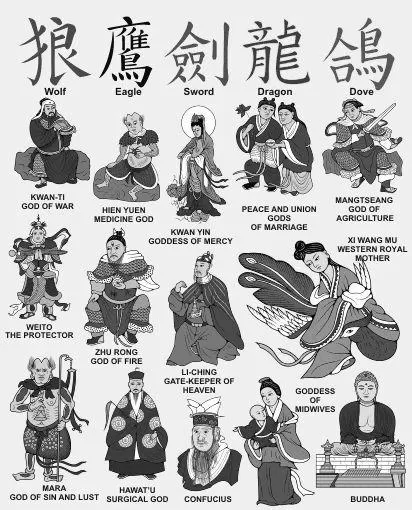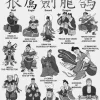The Shennong (Shen Nong) is a Chinese agriculture deity who is credited with the development of agriculture. He is said to have sown the first rice on earth. According to Sima Qian’s chronology, Shennong lived between 2737 and 2699 BC. Many people also call him the Emperor of Five Grains.
Shennong
The Chinese agriculture deity, Shennong, was born in 28 BCE in what is now Shaanxi province. He was also known as the First God of Five Grains, Yan Di, and the Red Emperor. The deity was associated with fire, and some legends say he taught people how to plow a field by using fire.
Shennong was also a patron of medicinal herbs. It is said that he ate hundreds of different plants to research their medicinal properties. In addition, he was responsible for the discovery of tea. However, his life was cut short when he consumed a yellow flowering weed. This caused his intestines to rupture, and there was no time to prepare an antidote.
As the creator of agriculture, Shennong is credited with helping China move from a loose society to an agrarian empire. His contributions to the world and for humankind have made him an enduring legend. Moreover, he is also regarded as the father of Chinese medicine and was instrumental in improving the lives of the Chinese people for thousands of years.
The name Shennong translates to “Divine Farmer.” In Chinese mythology, Shennong is considered the father of traditional Chinese medicine and agriculture. While he is revered in major cities, his shrines are more common in rural areas. In addition to his patronage for farmers, he is also revered by traditional herbal practitioners.
Chang’e
The goddess of the moon, Chang’e, was a popular deity in ancient China and is one of the most well-known. Her name comes from the Chinese character chang (pretty), which means “pretty young woman.” In Chinese mythology, she is the consort of the archer god Hou Yi, and she is most famous for being beautiful, with a milky skin, black hair, and lips as soft as cherry blossoms. Generally, Chang’e is depicted as a graceful young woman wearing flowing robes. However, her image is also sometimes depicted as a toad, with an ugly appearance.
The Chinese pantheon of gods is complex and lacks a clear hierarchy. The diversity of stories in the pantheon suggests that the stories are from different places in Chinese culture. This is partially due to the fact that the dominant philosophy has been Confucianism, which stresses rationality. Many scholars avoided writing about mythological figures, which is why illiterate people continued to preserve them in oral tradition.
The mythology also describes the origin of many cultural inventions. Huangdi’s role in these innovations is significant, as he is credited as the fountainhead of Chinese culture and civilization. According to one version, his role in the development of fire-drill and the domestication of animals and plants was crucial in helping people flourish in the ancient Chinese culture. The legend also credits Chang’e with the invention of fire, which allowed humans to travel to faraway lands by water.
Zhi Nu
The Chinese agriculture deity Zhi Nu is a mythological being who is associated with the craft of weaving and knitting. She is also known as the Weaver Girl. She is said to be the daughter of the Jade Emperor and the Heavenly Mother. Originally, Zhi Nu lived in the heavens and was responsible for knitting and weaving clouds. However, she had a mystical connection to the earth, and was given permission to visit it by her father. One day, when she was bathing in a river, Zhi Nu met the cow herder Niu Lang, who fell in love with her. The two became close and had two children.
Chinese legends attribute many of their prosperity to Zhi Nu. His name translates to “God of Riches and Prosperity,” and he appears in many different forms. As the god of prosperity, he is often depicted in red clothes. His star is the planet Jupiter. He is also associated with longevity. Some of his most common manifestations are as pairs of two figures.
The Chinese mythology also features another farming deity. Zhi Nu was born in rural China and was credited with the development of agriculture and medicine. He was one of the Three Sovereigns and sometimes one of the Five Emperors. However, some historians believe he was actually the same as Yan Di, an ancient mythical ruler. He was also considered the original lord of Chi You. He was a rival to Huang Di, who was worshipped by the Chinese as a god. The myths also describe him as a winged demon and a man-eating monster.
Caishen
Caishen is a popular Chinese god of wealth and prosperity. He is often depicted riding a black tiger, surrounded by attendants. He is especially revered during the Chinese New Year. He is known for blessing people with wealth and prosperity, and his temples are among the most numerous in traditional China.
The temple is in a rural county in Sichuan province. Because it is an unregistered religious site, the leaders have adopted strategies to avoid state interference. These include the establishment of civic associations within the temple grounds. These associations have enabled the temple to move from the black market into the gray community.
The worship of Chinese gods is a tradition that dates back many centuries. Although some gods developed later than others, all are very important to the Chinese people. In fact, some of them are still widely worshipped today. But, in most cases, the practices were forbidden in the government.
The Chinese believe that the gods of agriculture and nature work together. The goddess of the sea was the patron of fishermen and sailors. She was worshipped as far back as the Han Dynasty. This belief is based on the fact that she rescued people who got into trouble on a boat. The goddess was considered to be one of the most popular deities in all of China, and her devotion is widespread.
Houtu
Houtu, the Chinese agriculture deity, is a god of agriculture. Many of the stories in Chinese mythology revolve around agriculture. The deity is described in a variety of ways, including being bronze-headed, sharp-horned, and iron-skulled. Legend has it that the God was born with the head of a bull. At three days old, he began to speak, and within a week, he began plowing the fields. The Chinese also associate him with the water buffalo, a large animal used in all farming activities, including the marshy rice fields.
Houtu’s cult began when Wudi, an emperor of the Han dynasty, started worshipping the spirit of the earth in 113 BCE. Eventually, the deity became the dual patron deity of harvest and soil. During this time, he was worshipped as a god of the earth, and received sacrifices under the Sheji title. In older traditions, he was also referred to as Gou Long and Shen Nong, two deities related to each other.
The Hubei province is home to several unique and rare plants. Throughout the Hubei province, Houtu shrines can be found throughout rural areas. The deity’s birthday is celebrated every year on the 26th day of the fourth lunar month. The day is also celebrated by offering sacrifices of farm animals to the deity.







